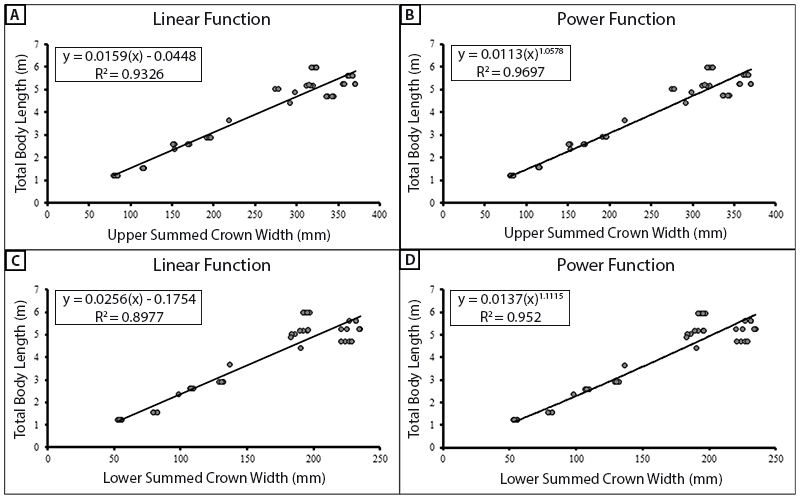FIGURE 1. Premise of summed crown width method. (A) Carcharodon carcharias dentition in lingual view, with applicable terminology. The right half is an illustration of the typical dental formula for C. carcharias. The left half is from a 5.18 m female with one less posterior tooth in the lower tooth series (originally figured in Hubbell, 1996; figure 5). Scale bar equals 5 cm. (B) The most complete known associated dentition of Otodus megalodon (CH-31-46P) in lingual view. Scale bar equals 5 cm. (C) Body length of fossil taxa is calculated under the assumption that the ratio of summed crown width to total body length (TL) is proportional in ecologically and taxonomically related species. Silhouette proportions for O. megalodon are based on Cooper et al. (2020). A/a = anterior, I = intermediate, and L/l = lateral. Uppercase letters denote upper teeth and lowercase letters denote lower teeth.

FIGURE 2. Phylogeny of macrophagous lamniforms included in this study, showing the relationship between the family Otodontidae (O. megalodon and O. chubutensis) and the family Lamnidae (C. carcharias, C. hubbelli, C. hastalis, I. paucus, and I. oxyrinchus).

FIGURE 3. Associated dentitions of Otodus megalodon in lingual view. (A) UF-VP-311000; (B) GHC 1; (C) CH-31-46P; and (D) UF-VP-460000. Scale bars equal 5 cm.

FIGURE 4. Associated dentitions of Otodus chubutensis in lingual view. (A) USNM 411881 (adapted from Perez et al., 2019; fig. 5); (B) USNM 299832; (C) GHC 3; and (D) UF-VP-312864. Scale bars equal 5 cm.

FIGURE 5. Associated dentitions of Carcharodon spp. in lingual view. (A) Carcharodon carcharias, GHC 4. (B) Carcharodon hastalis, GHC 5. Scale bars equal 5 cm. See Ehret et al. (2009) for images of the Carcharodon hubbelli dentition, UF-VP-226255.

FIGURE 6. Portion of summed crown width (SCW) for each tooth position. (A-B) Proportions from 10 modern Carcharodon carcharias dentitions. (C-D) Proportions from all eight fossil Otodus associated dentitions, after applying correction factors. (A, C) upper and (B, D) lower. Correction factors were derived from these proportions (see Appendix 5).

FIGURE 7. Comparison of body length estimates based on SCW direct proportions and Shimada (2002a) CH linear regression. (A-B) Otodus megalodon; (C-D) Otodus chubutensis; and (E-F) Carcharodon spp. (A, C, E) SCW direct proportions. (B, D, F) Shimada (2002a) CH linear regression. U = upper and L = lower.

FIGURE 8. Correlation between summed crown width and total body length in 17 modern Carcharodon carcharias individuals, comparing the upper versus lower dentition. (A) linear function (upper dentition: R2 = 0.93); (B) power function (upper dentition: R2 = 0.97); (C) linear function (lower dentition: R2 = 0.90); and (D) power function (lower dentition: R2 = 0.95).

FIGURE 9. Variation in body length estimates by tooth position. (A-B) Body length estimates from each tooth position in the Otodus megalodon dentition, using the Shimada (2002a) method. (A) CH-31-46P. (B) UF-VP-311000. (C-D) Comparison of body length estimates based on the SCW vs. Shimada (2002a) CH method, using the sample of upper teeth reported in Pimiento and Balk (2015). (C) SCW calculated using tooth proportions in CH-31-46P. (D) SCW calculated using tooth proportions in UF-VP-311000. Positive values indicate that the SCW method results in larger TL estimates than the CH method. Negative values indicate that the SCW method results in smaller TL estimates than the CH method. Teeth are subdivided based on the tooth positions assigned by Pimiento and Balk (2015); however, there is some overlap between categories given that some teeth were identified as antero-lateral (e.g., A1-L1) or latero-posterior (e.g., L3-L7).

FIGURE 10. Re-calculation of Otodus megalodon body lengths from Pimiento et al. (2010). (A) Re-calculation using the correct equations from Shimada (2002a). (B) Re-calculation using the SCW direct proportions method, showing results based on CH-31-46P and UF-VP-311000 as analogs separately.

FIGURE 11. Maximum body length estimation of Otodus megalodon. (A) Widest known tooth of O. megalodon (GHC 6), lingual view. The tooth enamel has been repaired inside the red polygon. Scale bar equals 5 cm. (B) Body length calculation for specimen GHC 6, using the associated dentition UF-VP-311000 as an analog and assuming the tooth represents position L1. SCWc = summed crown width corrected and TL = total body length. (C) Illustration depicting the mathematical equation used to solve for body length. Otodus megalodon artwork by Tim Scheirer, used with permission from the Calvert Marine Museum.


